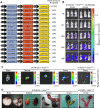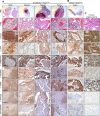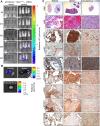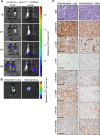Mouse genetic background influences whether HrasG12V expression plus Cdkn2a knockdown causes angiosarcoma or undifferentiated pleomorphic sarcoma
- PMID: 29731980
- PMCID: PMC5929423
- DOI: 10.18632/oncotarget.24831
Mouse genetic background influences whether HrasG12V expression plus Cdkn2a knockdown causes angiosarcoma or undifferentiated pleomorphic sarcoma
Abstract
Soft tissue sarcomas are rare mesenchymal tumours accounting for 1% of adult malignancies and are fatal in approximately one third of patients. Two of the most aggressive and lethal forms of soft tissue sarcomas are angiosarcomas and undifferentiated pleomorphic sarcomas (UPS). To examine sarcoma-relevant molecular pathways, we employed a lentiviral gene regulatory system to attempt to generate in vivo models that reflect common molecular alterations of human angiosarcoma and UPS. Mice were intraveneously injected with MuLE lentiviruses expressing combinations of shRNA against Cdkn2a, Trp53, Tsc2 and Pten with or without expression of HrasG12V , PIK3CAH1047R or Myc. The systemic injection of an ecotropic lentivirus expressing oncogenic HrasG12V together with the knockdown of Cdkn2a or Trp53 was sufficient to initiate angiosarcoma and/or UPS development, providing a flexible system to generate autochthonous mouse models of these diseases. Unexpectedly, different mouse strains developed different types of sarcoma in response to identical genetic drivers, implicating genetic background as a contributor to the genesis and spectrum of sarcomas.
Keywords: H-Ras; MuLE lentivirus; angiosarcoma; mouse model; undifferentiated pleomorphic sarcoma.
Conflict of interest statement
CONFLICTS OF INTEREST The authors declare that they have no conflicts of interest related to this manuscript.
Figures





References
-
- Fletcher C. WHO classification of tumours of soft tissue and bone. Fourth Edition. 2013 - PubMed
-
- Borden EC, Baker LH, Bell RS, Bramwell V, Demetri GD, Eisenberg BL, Fletcher CD, Fletcher JA, Ladanyi M, Meltzer P, O'Sullivan B, Parkinson DR, Pisters PW, et al. Soft tissue sarcomas of adults: state of the translational science. Clin Cancer Res. 2003;9:1941–56. - PubMed
Grants and funding
LinkOut - more resources
Full Text Sources
Other Literature Sources
Research Materials
Miscellaneous

